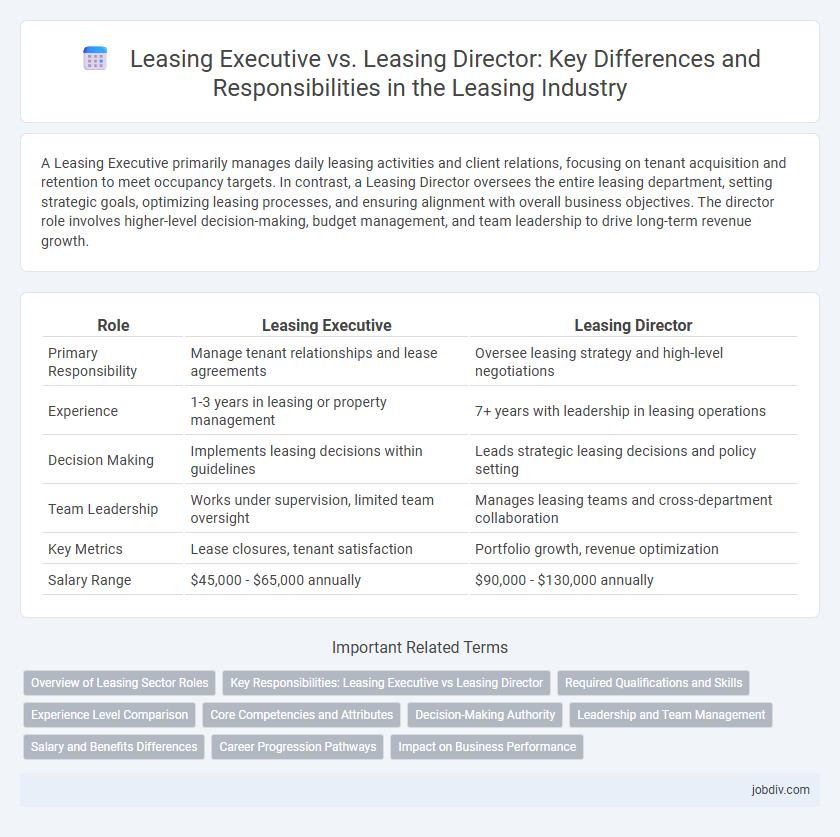A Leasing Executive primarily manages daily leasing activities and client relations, focusing on tenant acquisition and retention to meet occupancy targets. In contrast, a Leasing Director oversees the entire leasing department, setting strategic goals, optimizing leasing processes, and ensuring alignment with overall business objectives. The director role involves higher-level decision-making, budget management, and team leadership to drive long-term revenue growth.
Table of Comparison
| Role | Leasing Executive | Leasing Director |
|---|---|---|
| Primary Responsibility | Manage tenant relationships and lease agreements | Oversee leasing strategy and high-level negotiations |
| Experience | 1-3 years in leasing or property management | 7+ years with leadership in leasing operations |
| Decision Making | Implements leasing decisions within guidelines | Leads strategic leasing decisions and policy setting |
| Team Leadership | Works under supervision, limited team oversight | Manages leasing teams and cross-department collaboration |
| Key Metrics | Lease closures, tenant satisfaction | Portfolio growth, revenue optimization |
| Salary Range | $45,000 - $65,000 annually | $90,000 - $130,000 annually |
Overview of Leasing Sector Roles
Leasing Executives handle client interactions, negotiate lease terms, and support property marketing to drive occupancy rates in commercial or residential properties. Leasing Directors oversee the strategic planning, team management, and portfolio performance, ensuring alignment with company goals and maximizing rental income. Both roles require strong knowledge of real estate markets, tenant relations, and contract regulations, but the director focuses more on leadership and long-term growth within the leasing sector.
Key Responsibilities: Leasing Executive vs Leasing Director
Leasing Executives primarily focus on tenant acquisition, marketing rental properties, conducting property tours, and handling lease agreements to maximize occupancy rates. Leasing Directors oversee the entire leasing strategy, manage leasing teams, develop pricing policies, and analyze market trends to optimize revenue and tenant satisfaction. The Leasing Director also coordinates cross-departmental efforts to ensure alignment with overall property management goals.
Required Qualifications and Skills
Leasing Executives typically require strong customer service skills, a basic understanding of property management software, and experience in lease negotiation, often supported by a high school diploma or equivalent. Leasing Directors demand advanced qualifications such as a bachelor's degree in business or real estate, leadership experience, proficiency in financial analysis, and strategic planning capabilities. Both roles necessitate excellent communication, sales acumen, and knowledge of local real estate laws, with directors holding greater responsibility for team management and operational oversight.
Experience Level Comparison
Leasing Executives typically possess 1 to 3 years of industry experience focused on client interactions, property tours, and lease negotiations. Leasing Directors leverage 7 to 10+ years of expertise, overseeing multiple teams, developing leasing strategies, and driving high-level financial performance. The substantial experience gap translates into broader leadership responsibilities and strategic decision-making capabilities at the director level.
Core Competencies and Attributes
Leasing Executives excel in client relations, property marketing, and lease negotiation, demonstrating strong communication skills and attention to detail. Leasing Directors oversee strategic planning, team leadership, and portfolio management, requiring expertise in financial analysis, regulatory compliance, and decision-making. Both roles demand proficiency in leasing software and market trend analysis, but Directors emphasize leadership and operational oversight while Executives focus on direct tenant engagement and property leasing activities.
Decision-Making Authority
A Leasing Director holds higher decision-making authority than a Leasing Executive, overseeing strategic lease negotiations and final approvals on major contracts. Leasing Executives typically manage daily leasing operations and client interactions but escalate critical or high-value decisions to the director. The director's role includes setting leasing policies and aligning decisions with overall company goals, whereas the executive focuses on execution within those frameworks.
Leadership and Team Management
Leasing Directors oversee multiple leasing teams, setting strategic goals and ensuring overall portfolio growth through strong leadership and cross-department collaboration. Leasing Executives manage day-to-day leasing operations, directly guiding agents and handling client relationships to meet sales targets. Effective team management skills are essential at both levels, but Directors emphasize long-term vision and high-level decision-making while Executives focus on executing leasing strategies and motivating frontline staff.
Salary and Benefits Differences
Leasing Directors typically earn higher salaries than Leasing Executives, with average annual compensation ranging from $90,000 to $130,000 compared to $50,000 to $80,000 for Executives. Benefits for Leasing Directors often include performance bonuses, stock options, and comprehensive healthcare plans, whereas Leasing Executives usually receive standard benefits and commission-based incentives. The increased responsibility and strategic decision-making associated with Leasing Directors justify the significant differences in financial rewards and perks.
Career Progression Pathways
Leasing Executives typically begin their careers managing client relationships, conducting property tours, and negotiating lease terms to build foundational expertise in real estate leasing. As they gain experience and demonstrate leadership skills, they progress to Leasing Director roles, overseeing entire leasing teams, developing strategic marketing plans, and driving high-value portfolio growth. Career progression from Leasing Executive to Leasing Director involves mastery of lease administration, team management, and advanced negotiation tactics within competitive commercial or residential real estate markets.
Impact on Business Performance
Leasing Executives directly engage with tenants to maximize occupancy rates and reduce vacancy periods, driving consistent rental income and enhancing cash flow. Leasing Directors strategize portfolio growth and optimize lease structures, significantly influencing overall business scalability and profitability. The combined efforts of both roles ensure improved tenant retention and sustainable revenue growth within the leasing sector.
Leasing Executive vs Leasing Director Infographic

 jobdiv.com
jobdiv.com